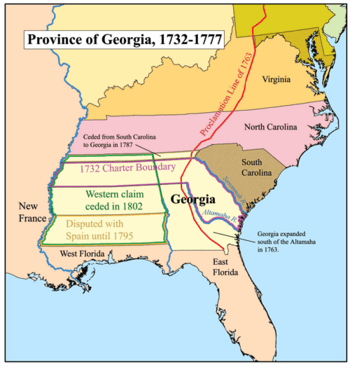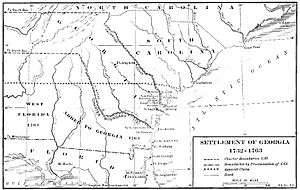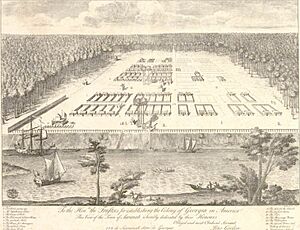Province of Georgia facts for kids
Quick facts for kids
Province of Georgia
|
|||||||
|---|---|---|---|---|---|---|---|
| 1732–1776 | |||||||
|
Flag
|
|||||||

Map of the Province of Georgia, 1732–1782
|
|||||||
| Status | Colony of Great Britain | ||||||
| Capital | Savannah | ||||||
| Official languages | English | ||||||
| Minority languages | Mikasuki, Cherokee, Muscogee, Shawnee, Yuchi | ||||||
| Religion | Church of England (Anglicanism) | ||||||
| Government | Proprietary colony (1732–1755) Crown colony (1755–1782) |
||||||
| King | |||||||
|
• 1732–1760
|
George II | ||||||
|
• 1760–1777
|
George III | ||||||
| Governor | |||||||
|
• 1732–1743
|
James Oglethorpe (first) | ||||||
|
• 1760–1782
|
James Wright (last) | ||||||
| Legislature | Commons House of Assembly (lower) General Assembly (upper) |
||||||
| Historical era | Colonial Era | ||||||
|
• Established
|
1732 | ||||||
|
• Disestablished
|
1776 | ||||||
| Currency | Georgia pound | ||||||
|
|||||||
| Today part of | United States | ||||||
The Province of Georgia, also known as the Georgia Colony, was one of the original Thirteen Colonies in British America. It was the last of these colonies to be founded. In 1775, it joined the American Revolution against British rule.
The colony was named after King George II of Great Britain. He officially approved its creation on April 21, 1732. General James Oglethorpe received the special document, called a charter, to start the colony.
Oglethorpe had a big dream for Georgia. He wanted it to be a special place for people who were struggling in England. This included those who owed money and couldn't pay, often called "the worthy poor." He hoped they could start fresh.
Georgia was also meant to be a protective zone. It would defend the other British colonies from Spanish Florida to the south. Because of this, Oglethorpe wanted strong, independent farmers living there. He initially banned slavery and alcohol in the colony. However, many colonists disagreed with these rules. The ban on slavery was removed by 1751. By 1752, Georgia became a Crown colony, meaning it was directly controlled by the British King.
Contents
Starting the Georgia Colony
| Historical population | ||
|---|---|---|
| Year | Pop. | ±% |
| 1740 | 2,021 | — |
| 1750 | 15,200 | +652.1% |
| 1760 | 19,578 | +28.8% |
| 1770 | 33,375 | +70.5% |
| 1780 | 66,071 | +98.0% |
| Source: 1740–1760; 1770–1780 | ||
Many people think Georgia was founded only for those in prison for debt. While General Oglethorpe wanted to help such people, the colony also aimed to be a place without forced labor. It eventually became a royal colony.
Here is how the first English settlers came to Georgia:
A group was chosen to visit jails. They helped release poor prisoners who were considered worthy. They carefully checked each person's background.
Thirty-five families, totaling 120 people, were chosen.
On November 16, 1732, these settlers sailed from Gravesend on the ship Anne. They arrived in Charleston, South Carolina, on January 13, 1733. The next day, they sailed to Port Royal. From there, small boats took them to the Savannah River.
General Oglethorpe explored the river to find a good spot for the settlement. On February 12, 1733, he led the settlers to Yamacraw Bluff. This area is now the city of Savannah, Georgia. They set up camp with help from Tomochichi, an elderly chief of the local Creek people. The Yamacraw tribe had lived there, but Oglethorpe arranged for them to move. This day is still celebrated as Georgia Day.
The original plan for the colony set its borders. It stretched between the Savannah River and Altamaha River. It then extended west all the way to the "south seas," which meant the Pacific Ocean. This land was once part of the Province of Carolina.
How the Colony Grew and Changed
The King's special council, called the Privy Council, approved Georgia's founding document on June 9, 1732. For the next 20 years, a group of trustees managed the colony. They received money from the British Parliament each year.
However, the trustees faced many challenges. After General Oglethorpe left, they found it hard to run the colony. On June 23, 1752, they gave control back to the King. By January 2, 1755, Georgia officially became a Crown colony. This meant the King directly governed it.
Dividing the Land into Parishes
From 1732 to 1758, Georgia was divided into smaller areas called districts and towns. In 1758, the colony was divided into eight larger areas called parishes. This happened without permission from the Native American tribes living there.
Some of these parishes included:
- The area around Savannah, Georgia became Christ Church Parish.
- Augusta, Georgia became the Parish of St. Paul.
- Other parishes were named St. Matthew, St. George, St. Philip, St. John, St. Andrew, and St. James.
After Britain won the French and Indian War, King George III made a new rule in 1763. This rule extended Georgia's southern border. It moved from the Altamaha River down to the St. Marys River. In 1765, four new parishes were created in this new land. These were St. David, St. Patrick, St. Thomas, and St. Mary.
Early Challenges and Growth
The Georgia colony started slowly. General Oglethorpe had strict rules. He did not allow alcohol. Colonists who came with help from the trustees could only own a small amount of land. They could not buy or sell more land.
People became unhappy with these rules. Eventually, Oglethorpe removed some of them. When colonists were allowed to own more land and when forced labor (slavery) was permitted, the colony grew much faster. Slavery was allowed starting in 1749. Some settlers, especially from Scotland, did not agree with slavery. However, by the time of the American Revolutionary War, Georgia was similar to other southern colonies.
Georgia During the American Revolution
When the American Revolution began, people in Georgia had different ideas. Some supported the British, while others wanted independence. In 1775, fighting started in Massachusetts. This led to strong supporters of independence, called Patriots, taking action in Georgia.
Patriots took weapons from the royal storage in Savannah, Georgia. They took control of the local government. Many who supported the British, called Loyalists, were forced to leave. In 1776, a special meeting declared Georgia's independence. They also created a new constitution for the new state. Georgia was also a base for attacks into British-controlled Florida.
In 1777, Georgia created its first eight counties. Before this, it had been divided into parishes. Most settlements were near the Savannah River. The western part of the new state was still controlled by the Creek Indian Confederation.
James Wright was the last Royal Governor of Georgia. He closed the royal assembly in 1775. He was briefly held by revolutionaries but escaped to a British warship in February 1776. During the war, Wright was the only royal governor to regain control of part of his colony. This happened after British forces captured Savannah on December 29, 1778.
British and Loyalist forces took back control of many areas, especially along the coast. However, Patriots continued to have their own governor, congress, and army in other parts of the state. In 1779, the British successfully defended Savannah from an attack by American and French forces. In 1781, American forces took back Augusta. When Britain lost the war, Governor Wright and British forces left Savannah on July 11, 1782. After this, the Province of Georgia was no longer a British colony.
Georgia as a New State
The new state of Georgia played an important role in the new United States. It was a member of the Second Continental Congress. It also signed the Declaration of Independence. Georgia was the tenth state to approve the Articles of Confederation on July 24, 1778. It was also the fourth state to join the Union under the U.S. Constitution on January 2, 1788.
On April 24, 1802, Georgia gave up its claims to western lands to the U.S. Congress. These lands had been part of its original colonial territory. These areas later became part of the Mississippi Territory. Eventually, they formed the states of Alabama and Mississippi.
See also
 In Spanish: Provincia de Georgia para niños
In Spanish: Provincia de Georgia para niños




